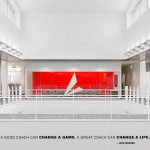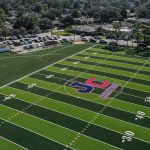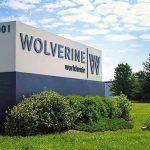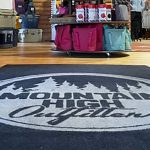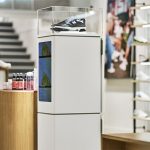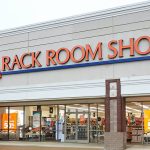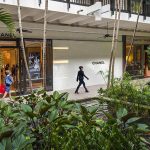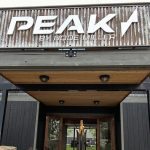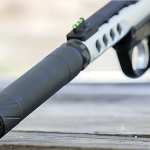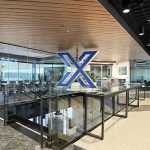Nike, Inc. shares were up almost 8% on Monday in early trading after the company signaled a strengthening U.S. business and order backlog portfolio. A shift in demand creation spending to the fiscal second quarter also helped the bottom line, nearly offsetting an increase in operating overhead. Last year at this time, Sports Executive Weekly reported that company management was “almost giddy with excitement” after reporting a fiscal first quarter that had the company hitting on all cylinders. While there was no overt elation on the quarterly conference call Monday morning, there was plenty of good news to go around.
Revenue for the quarter, which approached the $3.9 billion mark, was aided less this time around by changes in foreign currency exchange rates, which only accounted for about one point of growth in the fiscal first quarter ended August 31. The addition of the Starter brand to the mix was said to be immaterial to the top line and bottom line results. FX rate fluctuations did have an impact on gross margin, contributing about 180 basis points of the 80 basis point gain in total gross margins that were otherwise hurt by rising oil prices, shifting value strategies in Europe and Asia, a less favorable product mix in Europe, and higher costs to meet “strong unit demand” around the world.
SG&A benefited from a 10% decline in marketing spend, due in large part to the lack of a major sporting event this summer compared to last years Euro Championships and the Olympics. The company also moved some spend to the fiscal second quarter. The decline in demand creation partially offset a 12% increase in operating overhead. Currency changes accounted for about a point of the increases.
Nike management said they are also benefiting from macroeconomic trends that have consumers and retailers a bit spooked. They feel they are getting a bigger slice of the buy as retailers get cautious about the business amid the impact of Katrina, the London bombings, and continued increase at the gas pump. “Look at the U.S. as an example,” said Nike brand co-president Charlie Denson, “Were enjoying the strongest brand position weve seen in over five years.” He sees more of the buying decisions falling their way as the marketplace becomes more challenging.
Denson did acknowledge that they lacked a strong global product intro this season like they had last year with Shox, but pointed to the Nike Free initiative and growth in Nike Pro apparel, a strong Jordan brand, and growing acceptance by the skate consumer as key drivers for growth.
Don Blair, Nike Inc. CFO, said they still expect to see high-single-digit revenue growth for the year, but now see results closer to the upper end of that estimate. They see the U.S. region as the principal driver of more rapid growth, thanks to momentum in footwear. U.S. wholesale unit sales in footwear increased in the high-singles, while average selling prices rose in the low- to mid-single-digit range. Mr. Blair said they see continued strong growth in both units and ASPs for the five-month futures window. U.S. apparel eked out a 1% gain for the period as an 11% increase in Nike and Jordan brand product more than offset a decline in licensed apparel sales that resulted from the loss of the NBA license. They only have one more quarter to anniversary the NBA sales.
At U.S. retail, NikeTown stores posted a 6% comp store sales gain on top of the 9% increase in fiscal Q1 last year.
Pre-tax income in the U.S. rose 7.1% in the period to $345.2 million, due to higher sales volume and more SG&A leverage that offset a decline in gross margins, which declined 50 basis points on higher product costs and additional costs to meet “strong unit demand.” The decline in U.S. margins sliced about 20 basis points from the total company gross margin.
First quarter revenues for the EMEA region grew about 4% in currency-neutral terms, with footwear posting a 2% increase, apparel growing 5%, and equipment increasing 12% in currency-neutral terms. Management said they saw higher sales in “nearly every country in the region,” with particular strength in the U.K., Italy, and the emerging markets in the region.
Pre-tax profits for the region, which includes the Middle East, and Africa, were up 34.0% for the quarter to $330.2 million. Gross margin for the EMEA region jumped 240 basis points for the period, accounting for 80 basis points of overall NKE margin improvement.
Futures backlog at the end of the period was up 4.0% in current dollars, but was up 2.0% on a constant dollar basis.
| Nike, Inc. Fiscal First Quarter | ||||||
| Regional Operating Results | ||||||
| U.S. | EMEA | Asia/Pac | Americas | Other | Total | |
| Sales | $1,509 | $1,218 | $459.6 | $213.7 | $462.3 | $3,862 |
| Adj. Change* | n/c | 4.1% | 10.2% | 20.0% | n/a | +7.4% |
| Pre-Tax | $345.2 | $330.2 | $91.4 | $44.6 | $40.0 | $660.0 |
| Change | 7.1% | 34.0% | 44.2% | 119.0% | -0.5% | 30.6% |
| Backlog | 12.0% | 4.0% | 15.0% | 32.0% | n/a | 11.0% |
| Adj. Change* | n/c | 2.0% | 15.0% | 29.0% | n/a | n/c |
| * Adjusted for Currency Exchange Rates, Acquisitions | ||||||
In Asia-Pacific, China was again the primary driver for about 10% in currency-neutral growth, while Japan saw revenues “up slightly.” Japan backlog is up in double-digits. Currency-neutral footwear sales growth was pegged at about 5%, while apparel and equipment both jumped 16% on a currency-neutral basis for the period.
Asia-Pacific region pre-tax profit jumped 44.2% to $91.4 million in the quarter, easily reversing the 17% decline in pre-tax in the year-ago period. While gross margins declined by 180 basis points, reducing total company margins by 20 basis points, the decline was more than offset by increased SG&A leverage off of higher revenues and last years over-investment in demand creation in China and the implementation of a new supply chain system in Japan and Southeast Asia.
The Americas region saw currency-neutral sales surge 20% during the period, contributing to a 119% increase in pre-tax profit. A 330 basis point gain in gross margins also helped the cause for the region, while contributing about 20 bps to NKEs overall GM expansion.
As for the inventory figure, Blair said that nearly half of the increase came from a ramp up in the U.S. due to increased demand. The A/R line saw an increase from a transition to more normal credit terms in China.
>>> Keep in mind the backlog growth is coming after pulling out of Sears
>>> Management hinted at a desire to capture more of the fashion athletic business
Those nasty little Puma rumors just wont go away
| Nike, Inc. | |||
| Fiscal First Quarter Results | |||
| (in $ millions) | 2005 | 2004 | Change |
| U.S. | $1,509 | $1,402 | |

